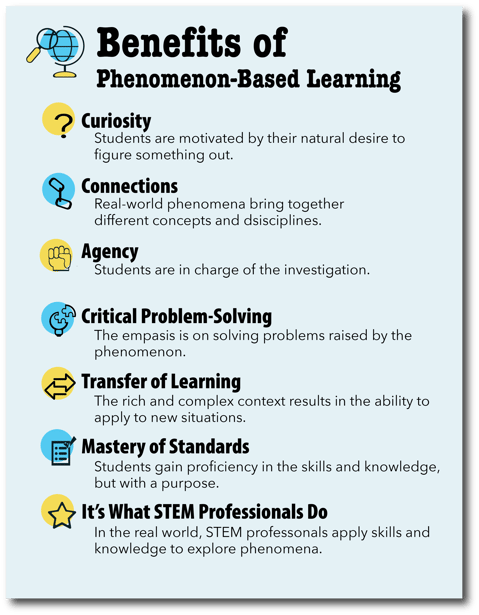
5 Easy Math Engagement Strategies for the Classroom
The news headlines are daunting. Math scores are down. School districts are scrambling to turn things around. And...
ALI Research Staff | Published April 07, 2023
Phenomenon-based learning takes students’ questions and turns them into learning opportunities. The premise may seem challenging, especially in classrooms with diverse needs and learning styles, but it can actually lighten a teacher’s load in terms of student engagement.
This type of learning is about real-world applications of science concepts. That’s powerful, exciting stuff for students who may not always feel connected to the curriculum. Let’s take a closer look at phenomenon-based learning and how it can support classroom instruction.
While some trace the origins of phenomenon-based learning to Finland’s 2016 educational revision (Valamis, 2023), the National Research Council (2013) introduced the concept of focusing learning on real-world phenomena more than a decade ago.
So, what is Phenomena, and why all the buzz?

A phenomenon is an observable real-world event, topic, or situation. In science, it can refer to scientific discoveries, natural disasters, or seemingly simpler topics that spark curiosity. It’s rooted in understanding the “why” behind science topics vs. the simpler “what.”
In the classroom, the key characteristic of a phenomenon (or phenomena, its plural form) is that it’s interesting and relevant enough to stimulate curiosity and critical thinking in students.
Examples include investigating quirky adaptations in wildlife, understanding why some plants grow in their community more than others, or analyzing the effects of the last natural disaster. Observable natural phenomena like solar eclipses are a great place to start.
Topics can vary depending on where students live and students’ natural curiousities. Students who live in the Midwest may not connect to topics like ocean currents and marine life. Or they may find them even more interesting because they have less experience in those environments.
Student interest surveys or open-ended science discussions are a great way to get a better understanding of where to start with linking phenomena to the curriculum.
Phenomenon-based learning is a more holistic approach to science education. Much like project-based learning, it hooks students into a lesson because the topic area is based on real-world issues and questions.
Phenomenon-based learning (PhBL) is a teaching approach that focuses on engaging students through real-world phenomena, such as observable events that can be explained by science.
The phenomenon is a launching point for inquiry that leads students through a series of investigations to explain it (Morrison et al., 2018).
In this way, it distinguishes itself from traditional methods that often present science concepts in isolation without context.
The benefits of PhBL go far beyond its contrast to more traditional methods.
This approach is a powerful tool for addressing many of the challenges science teachers face, including students’ lack of motivation and interest, insufficient background knowledge, poor mastery of standards, and inability to transfer learning.
Now that we’ve defined phenomena, let’s take a closer look at the benefits of phenomenon-based instruction:
Curiosity
One of the key benefits of PhBL is that it sparks student curiosity. When students encounter something they can’t explain, it creates a natural desire to learn more (National Research Council, 2012).
By tapping into this natural curiosity, we can motivate students to explore independently and seek out the information they need to answer their questions.
Connections
When science is presented as a series of unconnected facts, it is overwhelming and unappealing to many students.
On the other hand, a rich and meaningful phenomenon serves as a way for students to make connections between different science concepts, which helps them appreciate the big picture.
A phenomenon like a volcanic eruption can weave together geology, chemistry, and physics (Morrison et al., 2018).
This type of learning allows students to draw connections from the textbook to the real-world, making it one of the top benefits of PhBL.

Agency
An anchoring phenomenon creates a focal point for student-generated inquiry that addresses the question, “Why do I need to learn this?”
When students have the agency to plan and conduct their own investigations to explore a phenomenon, they answer that question themselves.
Critical Problem Solving
Another key benefit of PhBL is that it gives students a chance to practice critical problem solving. When the activity in the classroom shifts from simply acquiring knowledge and practicing skills to investigating a phenomenon, the focus shifts from learning about a topic to figuring out how something happens or why.
Building up students’ critical problem solving ability leaves them with not only a better understanding of the material but also with skills that are important in the 21st century.
Transfer of Learning
Because PhBL encourages students to explore and investigate real-world phenomena in a holistic and interdisciplinary manner, it enables students to transfer learning from one context to another. According to Akkas, E., & Eker, C. (2021), the transfer is more likely to occur when learning is situated in authentic and meaningful contexts due to greater metacognitive awareness.
PhBL allows students to make connections between different concepts, ideas, and disciplines, which helps them develop a more comprehensive and integrated understanding of the world.
This, in turn, helps them apply their knowledge and skills in new and unfamiliar situations. Furthermore, when students get accustomed to this approach, inquiry becomes a habit of mind for them that leads to a life-long love of learning and an inclination to pursue STEM careers.
Mastery of Standards
Although we can make a case for PhBL helping students develop higher-order thinking skills, we should remember that it also helps students master the standards. PhBL is a powerful learning tool for students, and one of its key benefits is that it can help students reach and master science standards.
When exploring phenomena, students practice observation, data collection, and analysis, skills essential for proficiency and mastery of science standards (National Research Council, 2012).
Furthermore, in the PhBL classroom, students gain proficiency in fundamental knowledge because it serves a purpose, answering an overarching question or designing a solution.
It's What STEM Professionals Do
One of the most important benefits of PhBL has little to do with the demands of schools, classrooms, and standardized tests. We want students to do more than pass the class or the test.
We hope that at least some of them will pursue a career in STEM. Preparing them for that means providing them opportunities to work like real scientists and engineers.
Professionals in STEM don’t study isolated facts and practice skills; they explore interesting phenomena.
Phenomenon-based learning should be based in student inquiry. It’s a way of getting students to ask questions and using what they know about science to answer those questions. This kind of instruction is more open-ended, so there may be more than one answer to their queries.
This doesn’t happen overnight. Students need modeling and instruction around how to ask and answer questions, especially when they’re used to more traditional methods of learning.
Students should also have some guidance around choosing phenomenon that make sense in their classroom. This can feel like it takes away from valuable classroom time, but the reward is a more independent group of student thinkers.
Student interests are a priority, but it’s still important to connect topics to classroom goals and standards. That starts with supporting students as they choose phenomena to investigate further.
A good anchor phenomenon is rooted in student interests and curiorities. It’s not something students can quickly Google. Ask students to think about those “I’ve always wondered why” questions with an emphasis on their own environment.
Good anchors are also observable. What kind of data can students collect around these wonderings? What kinds of tools will they need to figure out why something is happening? Are there any natural phenomena occurring around them that they’d like to learn more about?
Topics should lend themselves to interdisciplinary work. These projects may look organic, but they take time and effort to put together. Consider connecting questions with other educational areas, particularly in math and reading comprehension, and students’ long-term goals.
Teachers should always consider students’ diverse backgrounds and learning needs when starting a new science unit using phenomenon-based learning. Some students thrive when given open-ended assignments. Others will always need more guidance. Allow for flexible groupings to support all students at all levels.
The teacher’s role in phenomena-based learning is to guide students and give them the tools they need to be successful in navigating the curriculum. For phenomena-based learning itself to be successful, teachers must:
Phenomenon-based learning uses key 21st century skills of critical thinking, communication, collaboration, and creativity. It allows for both collaborative teamwork and solo efforts as students work to answer questions they posed.
In classrooms with access to a variety of tech tools, this type of learning can be a very technology-rich approach. Think of it as a tool in meeting increasingly important state standards around observation, critical thinking, and evidence-based reasoning.
Perhaps most importantly, phenomenon-based learning is a great way for teachers to learn more about students and what drives them to learn. Student engagement is so important in the classroom, and this type of learning is rooted in authenticity and student buy-in from start to finish.
Phenomenon-based learning is more than just the latest educational buzzword.
It’s a powerful approach to teaching that engages students, fosters curiosity, and builds the essential mastery of skills and concepts that results in higher achievement.
When students interact with science concepts in the context of real-world phenomena, they can make connections and transfer the learning to new and unfamiliar situations. (Perhaps even a standardized test item?)
Moreover, PhBL provides students with opportunities to practice essential skills, such as observation, data collection, and analysis, which are critical for mastery of science standards, potential STEM careers, and everyday life.
References
Akkas, E., & Eker, C. (2021). The Effect of Phenomenon-Based Learning Approach on Students' Metacognitive Awareness. Educational Research and Reviews, 16(5), 181-188.
Morrison, J.A. & Wyman, R.P. (2018). PhBL from Elementary Science: A Collaborative Approach. Journal of Science Education and Technology, 27(1), 61–71.
National Research Council. (2012). A Framework for K-12 Science Education: Practices, Crosscutting Concepts, and Core Ideas. Washington, DC: The National Academies Press. Doi: 10.17226/13165.
Valamis. (2023, March 21). What is PhBL? its benefits & examples.Valamis. Retrieved April 4, 2023, from https://www.valamis.com/hub/phenomenon-based-learning?_gl=1%2A20tjk2%2A_up%2AMQ..%2A_ga%2AMzM0MTU2NDgwLjE2ODA2MTIwMDM.%2A_ga_WH32P1Y0T3%2AMTY4MDYxMjAwMy4xLjAuMTY4MDYxMjAwMy4wLjAuMA..#origins-of-phenomenon-based-learning

The news headlines are daunting. Math scores are down. School districts are scrambling to turn things around. And...

Math assessment in California is changing. What used to be a compliance exercise or reporting tool is now becoming a...

You know the moment: a student’s eyes light up when the science experiment fizzes or the math puzzle helps them...